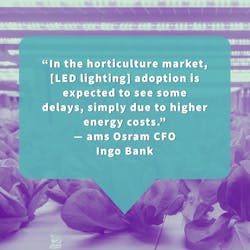Another top LED vendor has reported a horticultural slowdown, as ams Osram’s CEO said the sector turned “softer” in the third quarter, when sales across the company’s LEDs, lasers, and other chips fell 6% while corporate profits crashed by one measure but shot up by another.
Five days after Signify noted a third-quarter slump in horticulture, ams Osram boss Alexander Everke observed a similar decline.
“Exiting the quarter, we began to see demand trends in certain industrial markets such as horticulture turning softer, which reflects the unfavorable macroeconomic momentum,” Everke said on a web call with analysts to discuss financial results for the quarter ending Sept. 30.
Outgoing chief financial officer Ingo Bank intimated that growers cannot currently afford the expenditure on LED lighting because rising energy prices are constraining their budgets.
“In the horticulture market, the adoption is expected to see some delays, simply due to higher energy costs,” Bank told analysts.
The energy problem marks a conundrum, because the main reason that growers turn to LED lighting is to save energy.
But LED lighting comes at a premium compared to conventional horticultural light sources such as high-pressure sodium. In the current inflationary environment — including steadily rising energy prices — growers are holding off on purchases. Signify pointed out the same reason when it reported the falloff as last Friday.
Horticultural hopes
The slide is of particular concern to LED lighting and chip vendors, because horticulture has been one of the few bright spots in the LED industry’s efforts to redefine itself as more of a high-tech industry. Lighting companies have been trying with only limited success, for example, to outfit their wares with internet-connected sensors and communication chips and thus provide their customers with data collection and analysis that provides all sorts of insights on operations, sales, and assets.
The hoped-for metamorphosis — from the old caterpillar of selling chips, lamps, and luminaires, into the butterfly of high-tech goods and services — has been slowly evolving ever since long-lasting LED light sources became common, depriving the industry of its now obsolete and simpler business model of selling replacements.
Horticulture — or more broadly, controlled environment agriculture — fits the high-tech mold because growers can tailor LED wavelengths and intensities in a different optimized manner for different crops.
A prolonged slowdown would be an unwelcome blow to the industry. Everke was not optimistic, as he included horticulture on a list of sectors that could struggle in the “mid-term.” The company defines “mid-term” as through 2024.
While ams Osram has exited the luminaire portion of the horticultural lighting business, it still sells LED chips to horticultural luminaire makers. LEDs sales also stalled in the “metaverse” (augmented and virtual reality) segment that Everke has identified as key to growth, and in another area tagged for growth, digital health devices.
LEDs are only part of the product stable at ams Osram, which also sells sensors and other optical chips, including lasers. It also has a “lamps and systems” business that includes replacement headlamps for the automotive aftermarket, entertainment lighting, and some architectural lighting, although it sold off many of its nonchip-level operations to help focus on optical activities and to pay for the Osram acquisition.
General decline
Sales of all goods for the quarter fell 6% to €1.21 billion from €1.29 billion in the third quarter a year ago, as mainstay markets such as Android smartphones and automotive weakened.
The company provided two widely divergent accounts of profits. It reported an “adjusted net result” of €47 million, up considerably from €10 million in the third quarter of 2021. However, taking out the adjustments, it issued an IFRS statement showing a loss of €370 million for the quarter, compared to a loss of €40 million in the third quarter a year ago.
Ams Osram said the adjustments excluded “M&A-related, transformation and share-based compensation costs as well as results from investments in associates and sale of a business.”
The adjustments seem to indicate that the company is essentially still paying for ams’ acquisition of Osram, a company that was roughly four times the size of ams. The acquisition closed in June 2020 after a long and winding ordeal that then continued with wranglings over ams’ exact ownership stake and “dominance” of Osram.
In some ways, it is still playing out today. Ams Osram, based in Premstaetten, Austria, said the integration of the two companies is on track but still in process — nearly two-and-a-half years after the acquisition. It has been steadily selling off ams Osram divisions, a strategy that helps it focus on photonic operations as opposed to illumination, and which is also geared at helping to recover funds used for the acquisition.
“We are also in the final phase of the planned disposals and expect total proceeds from the disposals of more than €550 million,” Everke said. “We now look forward to closing the last two already signed transactions, one of which is expected to close this quarter, as well as completing the last smaller-scale disposal. All in all, we continue to realize our targets related to the acquisition and integration of Osram Licht AG.”
Geopolitics
The third-quarter downturn also reflected the broader world situation.
“We have seen significant changes in the macroeconomic and industry environment over the course of this year,” Everke said. “These include heightened uncertainty regarding the economic outlook, as well as widespread and meaningful inflationary pressures driven by geopolitical developments.”
Looking out through 2024, the company lowered its revenue outlook to €4.7 billion, from the previous €4.9 billion, and forecast and adjusted EBIT margin of roughly 13% for the same period, compared to a previous 15% or better.
“We are taking a cautious view given this demanding outlook for our markets and ongoing and expected cost inflation for our business and our customers, which is likely to impact mid-term volumes and technology adoption in certain markets such as horticulture, outdoor lighting, or certain Android and non-smartphone consumer applications, resulting in less favorable product mix assumptions,” Everke said.
He anticipated “flat” fourth quarter revenues of between €1.15 billion and €1.25 billion, and an EBIT margin of 6% to 9%. Unlike Signify and Fagerhult, which both indicated in recent quarterly reports that supply chain difficulties are easing, neither Everke nor Bank made such a reference.
Ams Osram is not alone among chip companies in troubled waters. The Washington, D.C.–based Semiconductor Industry Association last week reported that global semiconductor sales for the month of September 2022 were down 3.0% compared September 2021.
Despite the economic turmoil, Everke is holding out high hopes for the company’s future in micro LEDs, a promising new product category. He told analysts that ams Osram’s Malaysian site should start production by 2024.
He also said that, in a boost to business, one customer has agreed to provide a “substantial pre-payment” on future deliveries. Analysts speculated that the pre-payment relates to micro LEDs, but neither Everke nor Bank confirmed that.
LEDs Magazine will report more on the company’s micro LED hopes and other aspects of today’s analyst call in a separate article.
MARK HALPER is a contributing editor for LEDs Magazine, and an energy, technology, and business journalist ([email protected]).
For up-to-the-minute LED and SSL updates, follow us on Twitter. You’ll find curated content and commentary, as well as information on industry events, webcasts, and surveys on our LinkedIn page and our Facebook page.







